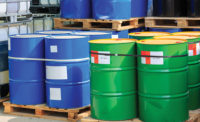1. Q: Do workplace labels need to replicate the shipping label (e.g., use red borders on the pictograms or include pictograms at all)?
A: The short answer is no. Workplace labels (e.g., in-plant container labels, secondary container labels) are performance-based and are not required to replicate the information on the shipped container. In fact, OSHA says employers can continue to use their current workplace labeling systems as long as they take into account the new GHS classifications when necessary.
However, the more an employer’s secondary label deviates from the shipping label, the more training the employer will likely have to do to ensure employees achieve the same level of understanding from the workplace label they would have received from the shipping label.
Labels on shipped containers have the following standard elements: product identifiers, manufacturer/supplier information, signal words, pictograms, hazard statements, precautionary statements.
2. Q: Are NFPA and HMIS labels still OK to use?
A: Yes, there is nothing in HazCom 2012 that prevents their use. In fact, the final rule on HazCom 2012, as published in the Federal Register (page 185), explicitly says, “Neither the proposal nor final rule prohibits the use of NFPA or HMIS rating systems.” However, the threshold is high for proving an alternative workplace labeling system, such as NFPA or HMIS, conveys the necessary understanding of chemical hazards to employees. When using a workplace label that does not replicate the shipping label, employers must ensure, through training, that employees still “get” all of the hazard information from the alternative label that they would have gotten from a shipping label.
3. Q: Will the way numbers are used to categorize hazards under GHS present a conflict with the way NFPA and HMIS labels use numbers? (i.e., in GHS, the lower the number, the greater the severity. With NFPA and HMIS systems, the higher the number, the greater the severity).
A: OSHA says no. As it explained in its 2009 Proposed HCS Revision, GHS category numbers are used on the safety data sheet (SDS) to determine the label elements that are required for a chemical, but the numbers themselves appear on the SDS only, not on the label. (Therefore, a GHS formatted label would not conflict with an NFPA or HMIS label on the same container.) In addition, when GHS category numbers appear on the SDS, there is contextual information included that helps explain the hazards in greater detail. OSHA also points out that this numbering scheme and approach has been used in the DOT’s transport regulations “for many years.”
4. Q: How will OSHA’s adoption of GHS affect DOT hazardous markings and placards?
A: OSHA’s adoption of GHS will not do much to affect DOT’s chemical hazard markings and placards. The DOT is actually in front of OSHA in its use of GHS pictograms and classifications for transport, having aligned with GHS and U.N. models in 2007/2008. OSHA’s alignment with GHS should bring the two agencies and their standards into greater agreement.
5. Q: Is electronic management of SDSs still permissible under HazCom 2012?
A: Yes, electronic management of SDSs is still permissible. Paragraph (g)(8) of HazCom 2012 says, “…Electronic access and other alternatives to maintaining paper copies of the safety data sheets are permitted as long as no barriers to immediate employee access in each workplace are created by such options.”
6. Q: Will we have to keep two books of MSDS until full GHS implementation?
A: No. During the transition period, May 25, 2012, through June 1, 2016, employers may be compliant with the old HCS or HazCom 2012, or a combination of the two. Employers should expect to have a mix of old and new safety data sheets for some time, and that is perfectly acceptable.
Employers will want to have a plan for processing the new SDSs as they come in as there may be new information or newly identified hazards that need to be addressed with employees via training.
7. Q: Must we maintain “old” MSDSs for 30 years as employee exposure records, per 1910.1020?
A: Technically, the answer is no. Per the Access to Employee Exposure and Medical Records Standard (29 CFR 1910.1020), you are required to have some record of the chemicals in use at your facilities for 30 years beyond their end-use date. This does not necessarily have to be via SDSs, although doing so is permitted and is a best practice that more easily meets the standard’s requirements than some other options do.
8. Q: What if an SDS is not provided by a manufacturer?
A: In the event a manufacturer or distributor does not provide GHS formatted labels or SDSs with shipments after the final HazCom 2012 compliance deadlines, OSHA would require employers to make a good faith effort to obtain the missing information from the manufacturer or distributor before allowing employee exposure to the chemicals. Note: manufacturers and distributors are not required to send updated SDSs or labels to past or current customers independent of a new shipment.
9. Q: Are SDSs required for consumer products?
A: The answer is maybe. If employees use consumer chemical products as directed by the manufacturer, at quantities not exceeding the average consumer, then you probably do not need an SDS for the product. Conversely, if employees use consumer chemical products in ways the average consumer does not, and/or their use exceeds average consumer quantity, then an SDS would likely be needed. It is best to err on the side of caution and use the compass of common sense — if you think you need one, you probably do. If in doubt, you can check with your local OSHA office to ensure compliance.
10. Q: What are the deadlines for employer compliance?
A: Employers have two specific compliance deadlines.
• December 1, 2013 – Employees must be trained on how to read GHS formatted SDSs and labels.
• June 1, 2016 – Employers must have updated their hazard communication program, made any necessary adjustments to their workplace labeling system, and trained employees fully on any new hazards identified during the GHS reclassification process.
Employers should consider training employees on the GHS formats well before the 2013 deadline, since they will be the first line of defense when it comes to identifying GHS styled SDSs and labels entering the workplace. Employers need to pull those new SDSs aside and compare them against the safety data sheets in their current library to identify any new information or hazards and to ensure those safety data sheets are swapped out for the updated ones. And remember, archiving old documents is a best practice.



